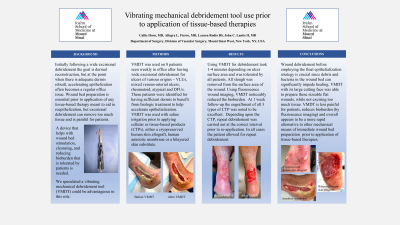Clinical Research
(CR-024) Vibrating mechanical debridement tool use prior to application of tissue based therapies
Friday, April 28, 2023
7:15 PM - 8:30 PM East Coast USA Time

Lauren Rodio, BS; John Lantis, MD
Introduction: Initially following a wide excisional debridement the goal is dermal reconstruction, but at the point when there is adequate dermis rebuilt, accelerating epithelization often becomes a regular office issue. Wound bed preparation is essential prior to application of any tissue based therapy meant to aid in reepithelization, but excisional debridement can remove too much tissue and is painful for patients. A device that helps with wound bed stimulation, cleansing, and reducing bioburden that is tolerated by patients is needed. We speculated a vibrating mechanical debridement tool (VMDT) could be advantageous in this role.
Methods: VMDT was used on 8 patients seen weekly in office after having wide excisional debridement for ulcers of various origins – VLUs, mixed venous-arterial ulcers, rheumatoid, atypical and DFUs. These patients were identified for having sufficient dermis to benefit from biologic treatment to help accelerate epithelialization. VMDT was used with saline irrigation prior to applying cellular or tissue based therapy (CTPs), either a cryopreserved human skin allograft, human amniotic membrane or a bilayered skin substitute.
Results: Using VMDT for debridement took 1-4 minutes depending on ulcer surface area and was tolerated by all patients. All slough was removed from the surface area of the wound. Using fluorescence wound imaging, VMDT noticeably reduced the bioburden. At 1 week follow-up the engraftment of all 3 types of CTP was noted to be excellent. Depending upon the CTP repeat debridement was carried out at the correct interval prior to re-application. In all cases the patient allowed for repeat debridement.
Discussion: Wound debridement before employing the final epithelialization strategy is crucial since debris and bacteria in the wound bed can significantly impede healing. VMDT with its large cutting face was able to prepare these sizeable flat wounds, while not excising too much tissue. VMDT is less painful for patients, reduces bioburden (by fluorescence imaging) and overall appears to be a more rapid alternative to other mechanical means of immediate wound bed preparation prior to application of tissue-based therapies.
Methods: VMDT was used on 8 patients seen weekly in office after having wide excisional debridement for ulcers of various origins – VLUs, mixed venous-arterial ulcers, rheumatoid, atypical and DFUs. These patients were identified for having sufficient dermis to benefit from biologic treatment to help accelerate epithelialization. VMDT was used with saline irrigation prior to applying cellular or tissue based therapy (CTPs), either a cryopreserved human skin allograft, human amniotic membrane or a bilayered skin substitute.
Results: Using VMDT for debridement took 1-4 minutes depending on ulcer surface area and was tolerated by all patients. All slough was removed from the surface area of the wound. Using fluorescence wound imaging, VMDT noticeably reduced the bioburden. At 1 week follow-up the engraftment of all 3 types of CTP was noted to be excellent. Depending upon the CTP repeat debridement was carried out at the correct interval prior to re-application. In all cases the patient allowed for repeat debridement.
Discussion: Wound debridement before employing the final epithelialization strategy is crucial since debris and bacteria in the wound bed can significantly impede healing. VMDT with its large cutting face was able to prepare these sizeable flat wounds, while not excising too much tissue. VMDT is less painful for patients, reduces bioburden (by fluorescence imaging) and overall appears to be a more rapid alternative to other mechanical means of immediate wound bed preparation prior to application of tissue-based therapies.

.png)